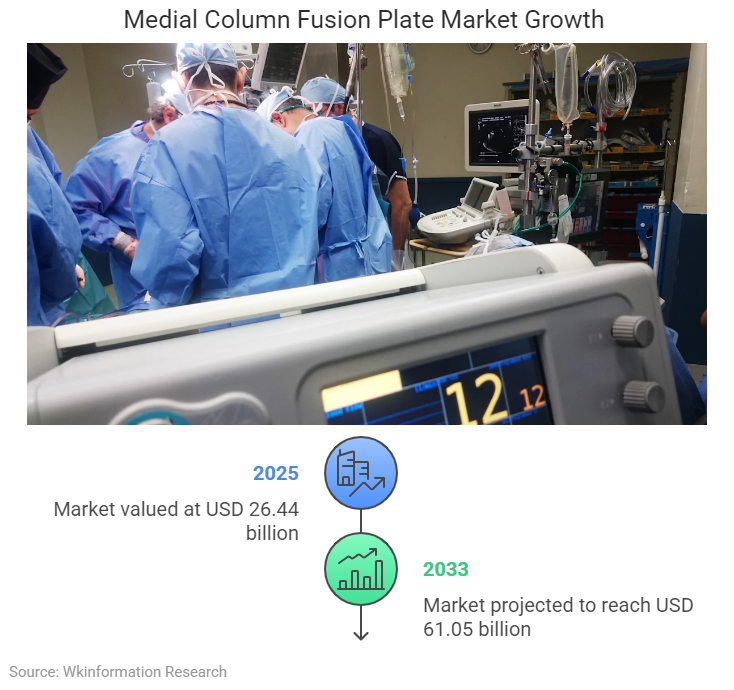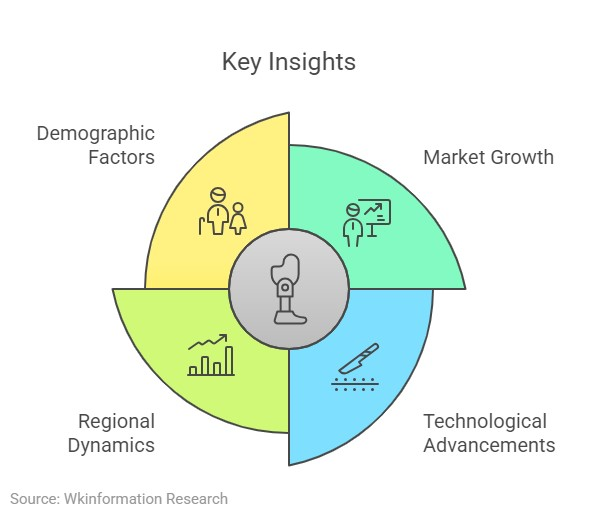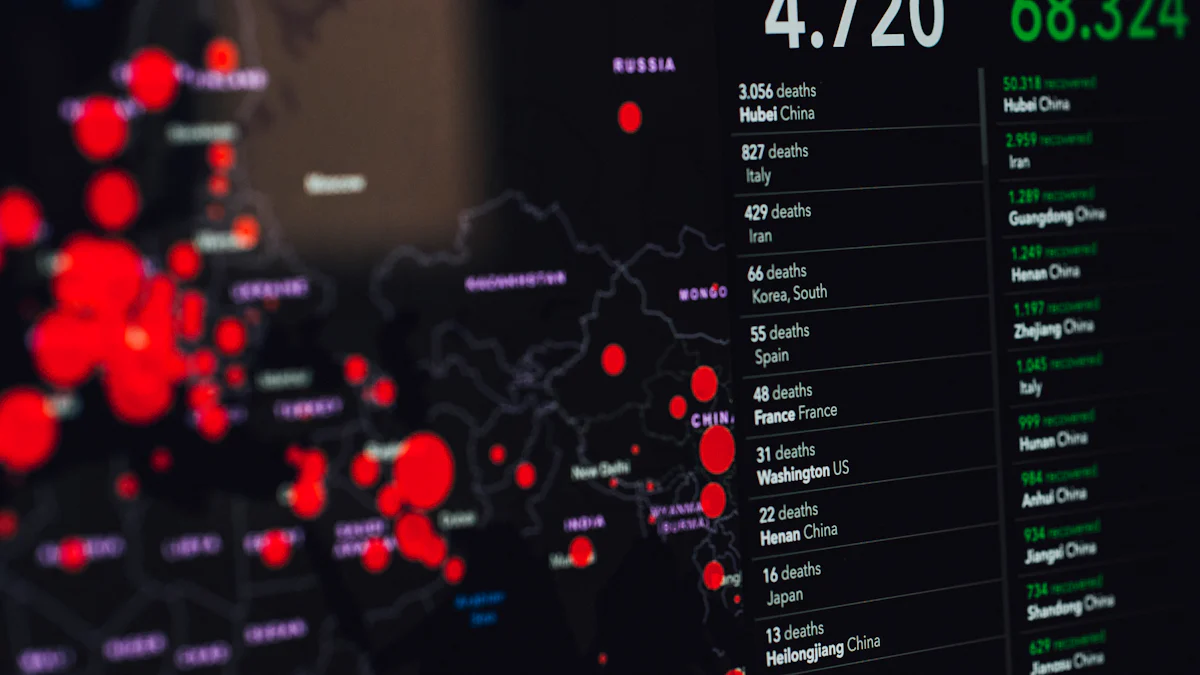
The Medial Column Fusion Plate Market plays a pivotal role in advancing orthopedic surgical techniques. These plates provide structural support for complex foot and ankle reconstructions, addressing conditions like severe fractures and deformities. Valued at USD 26.44 billion in 2025, the market is projected to reach USD 61.05 billion by 2033, growing at a robust CAGR of 11.03% from 2025 to 2033. This growth reflects increasing demand for innovative implant solutions and the rising prevalence of foot and ankle disorders globally. The market’s evolution underscores its significance in improving patient outcomes and driving surgical innovation.
Key Insights
- Medial column fusion plates help keep foot bones stable and joined. They improve results in surgeries for broken bones and foot problems.
- The Medial Column Fusion Plate Market may grow from $26.44 billion in 2025 to $61.05 billion by 2033. This is because more people want better bone surgery tools.
- New technology, like 3D printing and small cuts in surgery, is changing how doctors operate and helping patients heal better.
- North America is the top market because it has great hospitals. Asia-Pacific is growing fast because of more money spent on healthcare.
- Growing countries have big chances for growth. Older people and better healthcare make more people need bone surgery tools.

Medial Column Fusion Plate Market Overview

Definition and Purpose
Medial column fusion plates are specialized orthopedic implants designed to stabilize and fuse bones in the medial column of the foot. These plates play a critical role in addressing foot and ankle deformities, as well as in complex reconstructions. For instance, the SOLE™ Medial Column Fusion Plate exemplifies this purpose by offering structural support during surgical procedures. By enhancing bone alignment and stability, these plates contribute significantly to improved patient outcomes in orthopedic surgeries.
Market Size and Growth Projections
The Medial Column Fusion Plate Market has demonstrated consistent growth over the years. Analysts project a compound annual growth rate (CAGR) of 11.03% from 2025 to 2033, reflecting robust market potential. Several factors contribute to this upward trajectory:
- Technological advancements in implant design.
- Rising prevalence of foot disorders globally.
- Increasing demand for minimally invasive surgical procedures.
Geographically, North America dominates the market, driven by its advanced healthcare infrastructure and significant contributions from the United States. Meanwhile, Asia-Pacific and Europe are experiencing strong growth due to increased healthcare investments and rising awareness of advanced surgical solutions.
Key Growth Drivers
Several factors propel the growth of the Medial Column Fusion Plate Market:
- Rising Incidence of Spinal Disorders: Although primarily used for foot and ankle surgeries, the increasing prevalence of spinal conditions indirectly boosts demand for advanced orthopedic implants.
- Technological Advancements in Fusion Plate Designs: Innovations in material science have led to the development of lightweight, durable, and biocompatible plates, enhancing their effectiveness and appeal.
- Increasing Adoption of Minimally Invasive Surgeries: Surgeons increasingly prefer minimally invasive techniques due to their benefits, including reduced recovery time and smaller incisions, driving demand for advanced fusion plates.
These factors collectively underscore the market’s potential for sustained growth, particularly as healthcare systems worldwide continue to adopt cutting-edge surgical technologies.
Market Segmentation Analysis
By Type
Locking Plates
Locking plates represent a significant advancement in the Medial Column Fusion Plate Market. These plates feature screw holes that lock screws into place, providing enhanced stability and reducing the risk of implant failure. Surgeons often prefer locking plates for complex reconstructions, as they offer superior fixation in osteoporotic or weakened bones. This type of plate is particularly beneficial in cases where traditional screws may not provide adequate support.
Non-Locking Plates
Non-locking plates, while simpler in design, remain a vital option for many surgical procedures. These plates rely on the friction between the screw and bone for stability. They are often used in less complex cases or when cost considerations play a significant role. Non-locking plates continue to hold a steady market share due to their affordability and ease of use.
The market also includes other types of plates, such as standard fusion plates and anatomically contoured fusion plates, which cater to specific surgical needs.
By Application
Foot and Ankle Reconstruction
Foot and ankle reconstruction is a primary application for medial column fusion plates. These plates help address deformities, arthritis, and other conditions requiring bone realignment or stabilization. The increasing prevalence of foot disorders has driven demand for advanced solutions in this segment.
Trauma and Fracture Fixation
Trauma and fracture fixation represent another critical application area. Medial column fusion plates provide the necessary support for healing complex fractures, particularly in the midfoot region. Their ability to stabilize bones effectively makes them indispensable in trauma care.
By Region
North America
North America dominates the Medial Column Fusion Plate Market due to its advanced healthcare infrastructure and high healthcare expenditure. The United States plays a pivotal role, contributing significantly to market growth through innovation and adoption of cutting-edge surgical technologies.
Europe
Europe follows closely, benefiting from established healthcare systems and a growing focus on orthopedic advancements. Countries like Germany and the United Kingdom lead the region in terms of market share.
Asia-Pacific
The Asia-Pacific region is experiencing rapid growth, driven by increasing healthcare investments and an aging population. Rising awareness of advanced surgical solutions further fuels market expansion in countries like China, India, and Japan.
Rest of the World
Latin America and the Middle East & Africa are emerging markets with untapped potential. While these regions face challenges such as limited healthcare infrastructure, they show promise for future growth as investments in healthcare continue to rise.
Competitive Landscape of the Medial Column Fusion Plate Market
Major Market Players
Company Profiles and Market Share
The Medial Column Fusion Plate Market features several prominent players who drive innovation and maintain significant market shares. These companies include Medline Industries, LP, Arthrex, Inc., Paragon 28, BeMedical AG, Zimmer Biomet, Wright Medical Group N.V., Orthofix US LLC, and CROSSROADS EXTREMITY SYSTEMS.
Each company contributes to the market’s growth through its unique product offerings and strategic initiatives. For instance, Zimmer Biomet and Arthrex, Inc. lead in developing advanced implant technologies, while Paragon 28 focuses on specialized solutions for foot and ankle surgeries.
Recent Innovations and Developments
Recent advancements in the market highlight the commitment of these players to innovation. Companies like Wright Medical Group N.V. have introduced anatomically contoured plates designed for enhanced surgical precision. Similarly, Orthofix US LLC has developed lightweight, biocompatible materials that improve patient outcomes. These innovations reflect the industry’s focus on addressing complex surgical challenges effectively.
Strategic Initiatives
Mergers and Acquisitions
Mergers and acquisitions play a crucial role in shaping the competitive landscape. Companies like Zimmer Biomet have expanded their market presence through strategic acquisitions, enabling them to integrate advanced technologies and broaden their product portfolios. Such initiatives strengthen their positions in the global market.
Product Launches and Expansions
Product launches and geographic expansions remain key strategies for market players. Paragon 28 recently introduced a new line of locking plates tailored for complex reconstructions. Meanwhile, Arthrex, Inc. has expanded its operations in emerging markets, capitalizing on the growing demand for advanced surgical solutions. These efforts demonstrate the industry’s proactive approach to meeting diverse surgical needs worldwide.
Market Dynamics
Key Drivers
Increasing Prevalence of Foot and Ankle Disorders
The rising prevalence of foot and ankle disorders significantly drives the Medial Column Fusion Plate Market. Conditions such as arthritis, fractures, and deformities have become more common due to aging populations and lifestyle changes. These disorders often require surgical intervention, increasing the demand for advanced fusion plates. Healthcare providers prioritize solutions that enhance patient outcomes, further boosting the adoption of these implants.
Advancements in Implant Technology
Technological advancements in implant design and materials have revolutionized the market. Manufacturers now produce plates with improved durability, biocompatibility, and anatomical precision. These innovations reduce complications and improve surgical success rates. For example, the development of lightweight materials has made implants more comfortable for patients, while 3D imaging has enabled surgeons to achieve better alignment during procedures.
Restraints
High Costs of Surgical Procedures
Orthopedic surgeries and implants remain expensive, limiting accessibility in many regions. Patients in developing countries often face financial barriers, reducing the adoption of advanced solutions. The high cost of manufacturing and distributing these implants further exacerbates the issue.
Regulatory Challenges
Stringent regulatory requirements create significant hurdles for manufacturers. New entrants face delays in product approvals, while established companies must navigate complex compliance processes. The need for specialized training to perform these surgeries also restricts the availability of skilled professionals, particularly in underserved areas.
Emerging Trends
Adoption of 3D-Printed Implants
The adoption of 3D-printed implants represents a transformative trend in the market. These implants offer unparalleled customization, allowing surgeons to tailor solutions to individual patient anatomies. This technology reduces surgical time and enhances precision, making it a preferred choice for complex reconstructions.
Focus on Minimally Invasive Surgeries
Minimally invasive surgeries continue to gain traction due to their numerous benefits. These procedures involve smaller incisions, reduced recovery times, and lower risks of complications. The growing preference for these techniques has increased the demand for advanced fusion plates designed for minimally invasive applications.
Future Outlook for the Medial Column Fusion Plate Market

Growth Opportunities in Emerging Markets
Emerging markets present significant growth opportunities for the Medial Column Fusion Plate Market. Several factors contribute to this potential:
- The aging population in these regions is driving demand for orthopedic solutions due to the higher prevalence of foot disorders.
- Expanding healthcare infrastructure is enabling better access to advanced surgical procedures, including the use of medial column fusion plates.
- Technological advancements, such as 3D-printed implants and smart implant technologies, are fostering innovation and adoption.
- The increasing preference for minimally invasive surgical techniques is improving patient satisfaction and reducing overall healthcare costs.
These trends highlight the untapped potential in regions like Asia-Pacific, Latin America, and the Middle East, where investments in healthcare are steadily rising.
Role of Technological Advancements
Technological advancements are reshaping the Medial Column Fusion Plate Market, driving innovation and improving surgical outcomes. Key developments include:
| Evidence Type | Description |
|---|---|
| Technological Advancements in Fusion Plate Designs | Advances in material science and engineering are leading to more durable, lightweight, and biocompatible plates. |
| Personalized and Patient-Specific Implants | 3D printing technology supports the creation of implants tailored to individual anatomies, enhancing precision. |
| Shift Toward Minimally Invasive and Robot-Assisted Procedures | Fusion plates compatible with robotic systems are gaining traction, improving surgical accuracy and recovery times. |
Additionally, materials like titanium and polyetheretherketone (PEEK) are enhancing biocompatibility and durability. These innovations reduce post-operative complications and contribute to better patient outcomes.
Long-Term Industry Projections
The Medial Column Fusion Plate Market is poised for sustained growth in the coming years. Analysts predict steady expansion driven by increasing demand for advanced orthopedic implants and the adoption of cutting-edge surgical technologies. Emerging markets will play a pivotal role in this growth, supported by rising healthcare investments and awareness of innovative solutions.
The integration of technologies like 3D printing and robotics will further transform the industry, enabling more precise and efficient procedures. As healthcare systems worldwide prioritize minimally invasive techniques, the market will continue to evolve, offering improved solutions for complex foot and ankle surgeries. Long-term projections indicate a robust trajectory, with the market expected to achieve significant milestones by 2030 and beyond.
Overview
The Medial Column Fusion Plate Market continues to evolve, driven by advancements in material science and engineering. Key trends include a shift toward patient-specific fusion plates and a growing emphasis on clinical outcomes. Companies must prioritize innovation and strategic planning to remain competitive. Differentiated products, strategic partnerships, and investments in research and development are essential for sustained growth. Looking ahead, the market holds immense potential, with emerging technologies and minimally invasive procedures paving the way for improved patient care and expanded global adoption.
| Report Metric | Details |
|---|---|
| Report Name | Global Medial Column Fusion Plate Market Report |
| Base Year | 2024 |
| Segment by Type |
· Locking Plates · Non-Locking Plates |
| Segment by Application |
· Foot and Ankle Reconstruction · Trauma and Fracture Fixation |
| Geographies Covered |
· North America (United States, Canada) · Europe (Germany, France, UK, Italy, Russia) · Asia-Pacific (China, Japan, South Korea, Taiwan) · Southeast Asia (India) · Latin America (Mexico, Brazil) |
| Forecast units | USD million in value |
| Report coverage | Revenue and volume forecast, company share, competitive landscape, growth factors and trends |
FAQ
What are medial column fusion plates used for?
Medial column fusion plates stabilize and fuse bones in the medial column of the foot. Surgeons use them to treat deformities, fractures, and arthritis. These plates enhance bone alignment and provide structural support, improving surgical outcomes in foot and ankle reconstructions.
How do locking plates differ from non-locking plates?
Locking plates secure screws into place, offering superior stability for complex cases. Non-locking plates rely on friction between the screw and bone for support. Locking plates are ideal for weakened bones, while non-locking plates suit simpler procedures due to their affordability.
Which regions dominate the Medial Column Fusion Plate Market?
North America leads the market due to advanced healthcare infrastructure and high adoption of innovative technologies. Europe follows closely, while Asia-Pacific shows rapid growth driven by healthcare investments and an aging population. Emerging markets also present untapped potential.
What challenges does the market face?
High surgical costs and stringent regulatory requirements pose significant challenges. Limited access to skilled professionals in underserved regions further restricts market growth. These barriers impact the adoption of advanced implants, particularly in developing countries.
How is technology shaping the market’s future?
Technological advancements, such as 3D-printed implants and minimally invasive techniques, are transforming the market. These innovations improve surgical precision, reduce recovery times, and enhance patient outcomes. The integration of robotics and smart implants further drives progress in orthopedic care.
Global Medial Column Fusion Plate Market Report (Can Read by Free sample) – Table of Contents
Chapter 1: Medial Column Fusion Plate Market Analysis Overview
- Competitive Forces Analysis (Porter’s Five Forces)
- Strategic Growth Assessment (Ansoff Matrix)
- Industry Value Chain Insights
- Regional Trends and Key Market Drivers
- Medial Column Fusion PlateMarket Segmentation Overview
Chapter 2: Competitive Landscape
- Global Medial Column Fusion Plateplayers and Regional Insights
- Key Players and Market Share Analysis
- Sales Trends of Leading Companies
- Year-on-Year Performance Insights
- Competitive Strategies and Market Positioning
- Key Differentiators and Strategic Moves
Chapter 3: Medial Column Fusion Plate Market Segmentation Analysis
- Key Data and Visual Insights
- Trends, Growth Rates, and Drivers
- Segment Dynamics and Insights
- Detailed Market Analysis by Segment
Chapter 4: Regional Market Performance
- Consumer Trends by Region
- Historical Data and Growth Forecasts
- Regional Growth Factors
- Economic, Demographic, and Technological Impacts
- Challenges and Opportunities in Key Regions
- Regional Trends and Market Shifts
- Key Cities and High-Demand Areas
Chapter 5: Medial Column Fusion Plate Emerging and Untapped Markets
- Growth Potential in Secondary Regions
- Trends, Challenges, and Opportunities
Chapter 6: Product and Application Segmentation
- Product Types and Innovation Trends
- Application-Based Market Insights
Chapter 7: Medial Column Fusion Plate Consumer Insights
- Demographics and Buying Behaviors
- Target Audience Profiles
Chapter 8: Key Findings and Recommendations
- Summary ofMedial Column Fusion Plate Market Insights
- Actionable Recommendations for Stakeholders


